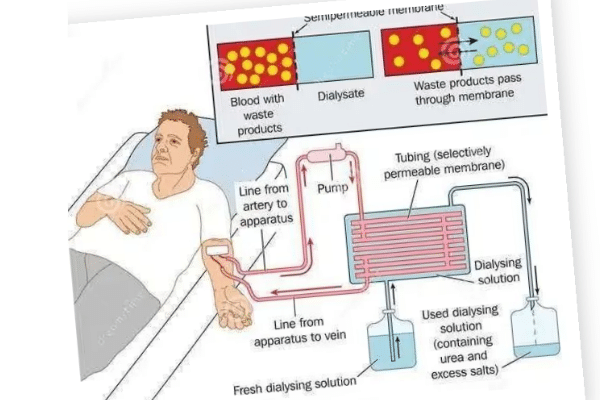dialysis catheter in the chest, a vital lifeline
2021-03-29
Hemodialysis is the main renal replacement therapy for uremic patients, and dialysis catheter in chest is one of their lifelines. It is generally accepted clinically that Arteriovenous Fistula (AVF) should be preferred for long-term vascular access.
And when patients have poor vascular conditions, are in urgent need of dialysis treatment or are in the pre-transplant transition period. Other problems prevent the establishment of an endovascular fistula (AVF or AVG), a dialysis catheter with a tunnel and polyester sleeve (TCC, or conduit tunnel, commonly known as a long-term catheter), can be chosen.

Advantages of the conduit tunnel
1. Easy to place and can be used immediately after placement.
2. Long service life. Due to the biocompatibility of the catheter material, it can be fixed to the skin. The polyester sleeve forms a closed bacterial barrier in the subcutaneous tunnel, which reduces the incidence of infection.
3. Relatively low impact on hemodynamics, also suitable for patients with poor cardiac function.
4. Comfortable to use. Dialysis does not require venipuncture, reducing pain.
_378190.png)
Common long term complications of conduit tunnel
1. Malfunction: fibrin sheath/thrombosis, catheter folding.
2. infection: bacterial colonization, orifice infection, tunnel infection, catheter-associated bloodstream infection, catheter-associated migratory infection.
3. central venous stenosis/occlusion.
4. catheter slippage, rupture, catheter polyester sleeve dislodgement, etc.
Perioperative precautions for tunnelled catheters
1. Comply with the doctor's orders to improve relevant examinations and truthfully tell the doctor about past medical history and medication history.
2. The catheter needs to be performed in a separate operating room. It is recommended that the patient bathe and change surgical gown before surgery to keep the skin clean.
3. If the catheter is placed in the internal jugular vein, the patient should lie on their back. The surgical towel will cover the head and face during the operation due to the need for a sterile barrier, so inform the medical staff in time if there is any discomfort.
4. Postoperatively, observe the wound dressing for blood leakage and the skin around the cannula and its placement for swelling.
5. Pain usually disappears after 1~3 days after surgery. During this period, if the pain is unbearable, pain medication can be used under the physician's guidance.
How should I perform daily care?
1. Prevent bleeding and thrombosis
①Patients with unexplained skin bruising, bleeding from gums or other parts of the body, or female period should inform the doctor in advance to avoid aggravating bleeding due to the use of anticoagulants.
②Patients with severe anaemia and low red blood cells and platelets should use low-dose anticoagulation or heparin-free dialysis during treatment, depending on the condition.
③Once local bleeding from the catheter is detected, apply pressure and go to the hospital promptly.
④Use anticoagulant drugs, such as aspirin and clopidogrel, reasonably as prescribed by the doctor, and do not stop or increase the dosage on your own.
⑤ Sleep in a flat position or on the opposite side of the tube to prevent pressure on the catheter and the local area.
2. Prevent infection
①Create good hygiene habits, keep the catheter and surrounding skin clean and dry. A sterile waterproof dressing can seal the catheter and the surrounding skin before bathing to avoid getting wet. If the catheter dressing is inadvertently wet or contaminated, it should be promptly changed at the hospital.
②. A mask should be worn throughout the treatment because of the large number of Staphylococcus aureus present in the nose that can easily cause catheter infection.
③. Do self-protection by not going to or rarely going to public places. Monitor your body temperature daily and seek medical attention if there is an increase in temperature or signs of skin redness, swelling, fever or pain at the cannula.
④. Do not use the hemodialysis catheter for other purposes, such as drawing blood, infusion, transfusion, etc., if it is not a special or emergency, prevent infection and blockage.
3. Prevent the tube from slipping
①. Avoid strenuous activities and heavy physical work, but you may engage in light work or daily chores to prevent slipping of the catheter due to pulling when your condition allows.
②. Choose clothes that are easy to put on and take off (such as cardigans), and avoid clothes that cover the head as much as possible. When dressing and undressing, be careful not to move too much and not move too hard to avoid pulling or touching the catheter to cause loosening or bleeding due to pulling out of the catheter.
Maysino is a manufacturer of single and double triple lumen hemodialysis catheter set/dialysis set in China; our factory mainly produces medical conduit tunnel, wound dressing and Single-use nitrile gloves and other related products, our headquarter is in Nanjing, China.
please contact us for business cooperation.

